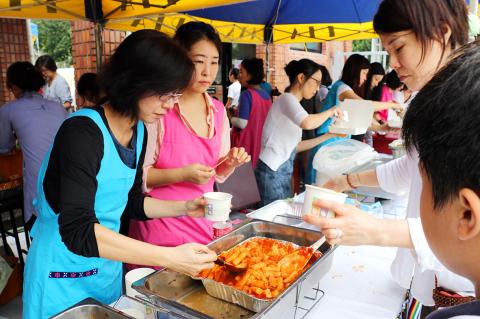If there’s one thing that the doting parents of Taipei American School (TAS) care fervently about (besides their children’s SAT scores), it’s nourishing young minds. The international food fair organized by the Parent Teacher Association (PTA) is an event that draws thousands of foodies from the expat community of suburban Tianmu and beyond every year. The fair returns tomorrow for its 33rd year.
From Vietnam to Venezuela, more than 20 countries are represented and around 8,000 visitors are expected to show up. In addition to sushi, samosas and shaved ice — all prepared by the gracious parents — there will also be arts and crafts stations, a bouncy castle, as well as a haunted house full of goblins and ghosts orchestrated entirely by the high school students.
Speaking on behalf of the PTA, Priya Purswaney says: “The parents put in a lot of hard work months before the event to ensure that it goes smoothly.”

Photo courtesy of TAS
Purswaney adds that in recent years, the fair has drawn more volunteers from outside of the TAS community, and that local schools in Taipei even arrange field trips to visit the fair. More student associations and clubs at TAS have also been involved in planning the activities for this year’s fair, so expect to see new booths in addition to the usual face painting, water balloon toss and stands selling fake tattoos.
“The fair has become more international and features double the number of clubs, so that means double the fun,” Purswaney says.
Though it’s expected that when you bring a bunch of parents together, there’s bound to be some squabbles.

Photo courtesy of TAS
Nevertheless, the PTA says the preparation is mostly a concerted effort, and that what’s more important is that the parents have the students’ well-being at heart.
“The only thing the TAS parents get out of it is the satisfaction of doing something for the school,” Purswaney says.
If there’s one thing they can agree upon though, it’s promoting healthy eating (never mind the cotton candy stand that seems to have the longest line every year). The school’s cafeteria does indeed have an amazing assortment of gourmet dishes that would put many seasoned restaurateurs to shame. As for the fair, the food is mostly home-cooked or sponsored by top restaurants around Taipei.
“It’s definitely important to teach children at an early age the importance of a healthy diet.” Purswaney says. “The TAS cafeteria is a no fry zone, and vendors at the fair are also encouraged to reduce the amount of fried goods.”
The food fair starts tomorrow at 10am and is open to the public. A portion of the proceeds will go to developing the school, while the rest of the funds is allocated to different charities each year.

Oct. 27 to Nov. 2 Over a breakfast of soymilk and fried dough costing less than NT$400, seven officials and engineers agreed on a NT$400 million plan — unaware that it would mark the beginning of Taiwan’s semiconductor empire. It was a cold February morning in 1974. Gathered at the unassuming shop were Economics minister Sun Yun-hsuan (孫運璿), director-general of Transportation and Communications Kao Yu-shu (高玉樹), Industrial Technology Research Institute (ITRI) president Wang Chao-chen (王兆振), Telecommunications Laboratories director Kang Pao-huang (康寶煌), Executive Yuan secretary-general Fei Hua (費驊), director-general of Telecommunications Fang Hsien-chi (方賢齊) and Radio Corporation of America (RCA) Laboratories director Pan

The classic warmth of a good old-fashioned izakaya beckons you in, all cozy nooks and dark wood finishes, as tables order a third round and waiters sling tapas-sized bites and assorted — sometimes unidentifiable — skewered meats. But there’s a romantic hush about this Ximending (西門町) hotspot, with cocktails savored, plating elegant and never rushed and daters and diners lit by candlelight and chandelier. Each chair is mismatched and the assorted tables appear to be the fanciest picks from a nearby flea market. A naked sewing mannequin stands in a dimly lit corner, adorned with antique mirrors and draped foliage
The consensus on the Chinese Nationalist Party (KMT) chair race is that Cheng Li-wun (鄭麗文) ran a populist, ideological back-to-basics campaign and soundly defeated former Taipei mayor Hau Lung-bin (郝龍斌), the candidate backed by the big institutional players. Cheng tapped into a wave of popular enthusiasm within the KMT, while the institutional players’ get-out-the-vote abilities fell flat, suggesting their power has weakened significantly. Yet, a closer look at the race paints a more complicated picture, raising questions about some analysts’ conclusions, including my own. TURNOUT Here is a surprising statistic: Turnout was 130,678, or 39.46 percent of the 331,145 eligible party

The election of Cheng Li-wun (鄭麗文) as chair of the Chinese Nationalist Party (KMT) marked a triumphant return of pride in the “Chinese” in the party name. Cheng wants Taiwanese to be proud to call themselves Chinese again. The unambiguous winner was a return to the KMT ideology that formed in the early 2000s under then chairman Lien Chan (連戰) and president Ma Ying-jeou (馬英九) put into practice as far as he could, until ultimately thwarted by hundreds of thousands of protestors thronging the streets in what became known as the Sunflower movement in 2014. Cheng is an unambiguous Chinese ethnonationalist,